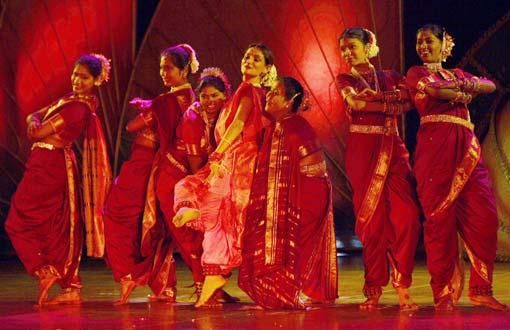Mumbai: A peek into Maharashtra's 700-year-old folk theatre of tamasha and lavni dance form reveals that it is still an uphill struggle for survival of its artistes committed to amusing the masses in the remote villages and towns of this state and standing up to the invasion of "filmi" entertainment.
Marathi films have shown the glamorous side of this art, which has often lost its grace and sensuality by eroticism through the ages.
The Maharashtra Government has at times pitched in to support the artistes through grants and pension.
Fresh lease of life
And educated lavni artistes such as Surekha Punekar and Rajashree Nagarkar are setting up schools to train a new class of young women to revive lavni and give it a fresh lease of life.
However, for the dozens of troupes and their families constantly on the move, life for the tamasha and lavni artistes is as poor as the rural masses they cater to, says Shirish Shete, a photo-journalist working with the Press Trust of India.
His book, Dancing Maidens, is a nine-year-old personal journey of photographing and documenting tamasha - learning about the art form passed down for generations and capturing the magical beauty of these artistes as well as the tough grind of their unseen life.
Visual tribute
His coffee table collection in English, the first of its kind, is a visual tribute to these women and men. As much as he was mesmerised by these folk artistes, he was equally moved by their lifestyle.
The worst sufferers of these wandering troupes are their children, he says. From the stage of infancy when nursing mothers have to disengage their babies to take to the stage and not providing formal education during their childhood, it is not surprising that at a tender age boys start playing the musical instruments and the girls put on "ghungroos" or ankle bells to learn to dance.
Their childhood is also wrought with sickness since their parents are ignorant of vaccination and baby care. Stomach ailments are common since clean drinking water is a luxury.
"Tukaram Khedkar, a renowned tamasha artiste lost his life due to lack of medical treatment on time," writes Shete. Despite suffering from dysentery, he kept on playing his role of Shivaji Maharaj in Raigadchi Rani in a small village of Bokta in Nashik district. By the time he was taken to Pune, on doctor's advice, he died on the way.
Health ruined
Excessive dancing for survival, cheap cosmetics and the heavy "ghungroos" weighing 10-15 kg can further ruin their health. Moreover, accidents, floods, electrocution and fire can destroy their tents and their livelihood. Yet, these tamasha performers have kept alive their art for centuries, as can be seen at the annual fair in Narayangaon which draws tamasha troupes from all over to offer prayers to a local deity as well to strike business deals.
Or at the pilgrim centres in Alandi and Pandharpur where Shete had a field day photographing artistes performing into the night.
Show goes on
During his travels across Western Maharashtra to lavni theatres in Chauphula, Supe, Pune, Modnim in Pandharpur district and Narayangaon, at times with Professor Prakash Khandge, Lok Kala Academy, Mumbai University, they met prominent lavni artists.
"Lavni has both the joy of dancing and sorrow of not having enough connoisseurs to appreciate the effort," says Khandge.
"Nevertheless, the show goes on."













